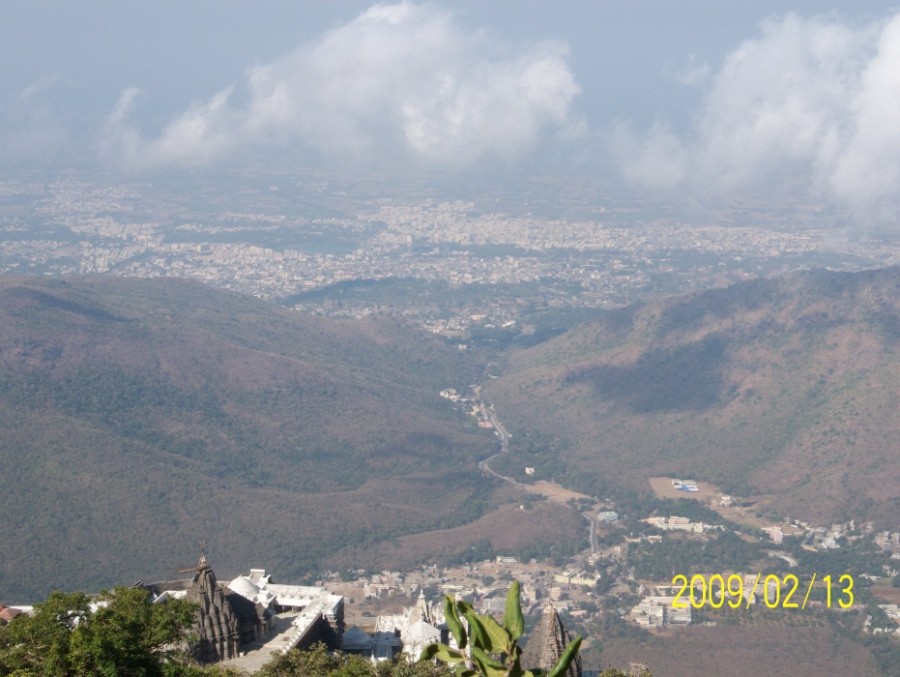Chapter outline and page reference:
Kushasthali and Dwaraka 73
Minnagara 74
Ushanasa Kruta 76
Manipur, Chandraketupur, Raivatanagara, Purvanagar and Pauratanpur 77
Surastranagara 78
Syrastra 79
Suvarnagirinagar or Sarvbhoum Narendrapur 79
Yavanagadh 80
Yavadhika 81
Ugrasenagadha, Ugrasenapura, Tejalapura and Khangaragadha 81
Girinagar 82
Giridurga 85
Giripura 87
Jhimjharakota 88
Jehanpanah 88
Jirnaprakar, Jiran Prakar 88
Jirnavapra 89
Mustafabad 89
Junagadh, Jirangadh, Jirandurg, Jirnadurg, Jirnadurgapura, etc 90
Jirnabhidha 94
Mandalgarh 94
Karnal 95
Unnatadurga 95
Asaldurga or Asalgarh 96
Chapter preview (first two pages only):
Figure 18. A view of Junagadh City from Mount Girnar, with Girnar Taleti and Sonarekh Valley in mid-ground (photo by Wainer 2009).
Kushasthali and Dwaraka
The idea that the present site of Junagadh could be where the ancient cities of Kushasthali and subsequently Dwaraka (= Dwaravati, i.e. city of many gates) once stood is discussed in the following chapter (Chapter 3). Other names of Dwaraka, that may well signify Junagadh, include Sauripura (e.g. Bhattacharya 1939, page 57), Dwarakapuri, Dvaravati, Anartapuri, Vrsnyandhakapuri (e.g. Athavale 1954), and Mahanagari (e.g. Singh 1994, page 67). Majmudar (1960, Page 288) pointed out many passages in the Mahabharata and Purans where Anarta is defined as the: ‘Region comprising North Gujarat and Surastra whose capital was Kusasthali or Dvaraka’. Anartapuri is given as another name of Kusasthali or Dvaraka (e.g. Bhagavat Puran I. 14.25). Dwaraka is regarded as one of the ‘seven puris’ (spiritual centres or sacred cities) of India which offer moksha or liberation. Therefore these saptapuris are tirths which are also called mokshapuris.
It is probably Dvaraka that was represented by Pliny (1st century AD) as Beccare, by the Periplus of the Erythraean Sea (1st century AD) as Baraca, and by Ptolemy (2nd century AD) as Barake. Lafont (2000, page 322) made the point that: ‘The location of Barake is uncertain, and the antique Dwaraka of the Indians, traditionally placed at the western point of the peninsula of Guzerate, seems to be precisely this same city, renowned for its commercial relations.’ When referring to Dvaraka, Jain (1969, page 48) tells us that: ‘According to Vasudevahindi (about 5th century AD), it was a chief town of Anattha (Anarta), Kusattha (Kusgrta), Surattha (Saurastra) and Sukkarattha (Suskarastra)’, and he also wrote that: ‘Baravai (Dvaravati or Dwaraka, modern Junagarh) was the capital of Saurashtra; it was also known as Kusasthali.’ Bajpai (1967) referred to the Vasudevahindi’s mention of this town, but he provided the spelling ‘Baragi’, and he suggested that it was equivalent to the Barvai of other early literature, a town that itself was identical with the present site of Junagadh. Bajpai also wrote that, according to the Brhatkalpa-bhasya (1.1123), in reference to Barvai: ‘here dwelt Kanhavasudeva and Andhagavanhi’.
The 4th Upanga text of Svetambar canonical literature, the Prajnapana by Arya Syama who flourished some 376 years after Mahavir, mentions in one sutra a list of Janapadas with their capitals, which includes both Kusavarta with its capital Sauripura, and Saurastra with its capital Dvaravati. This appears to be an inadvertent repetition, as Kusavarta and Saurastra were one and the same Janapada, just as Sauripura and Dvaravati are different names for the same city (Chatterjee 1978, page 249).
The Skand Puran (VII. iv. 2.3–4) mentioned that ‘Kusasthali’ got its name from Rama’s son Kusa, who established it’ (Majmudar 1960, page 294). Srinivasan (1986) stated that: ‘In Dwaraka mahatmya, the golden city was referred to as Kusasthali, since it was founded by Kusa (II; 4). In the Avantikhanda of Skandapurana, however, it had been stated that the area came to be known as Kusasthali, because Brahma placed a handful of kusa grass for Lord Krsna, to identify the spot as a holy place for establishing the Yadava settlement and that this place was earlier known as Hemarsrnga. Thus, there is a contradiction in Skandapurana itself about the name of the region.’
Minnagara
Indraji and Jackson (1896, page 15) suggested Minnagara, as mentioned in the Periplus, as another name for Girinagar, i.e. Junagadh: ‘The author of the
